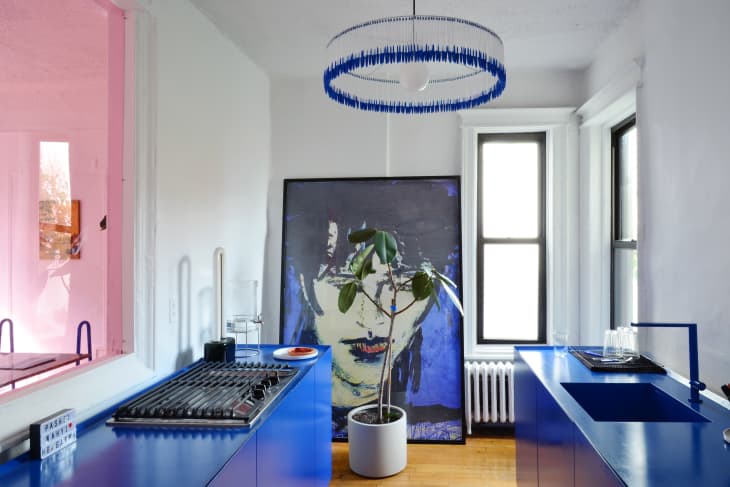Here’s What You Should Know Before You Buy Oversized Wall Art

There it is: your gallery walls have been the thing for quite some time now, oversized art can and should have its moment in the sun, too. Of course, evaluating, buying, and hanging a large piece of art is a herculean task that can definitely be intimidating and almost certainly will be pricey.
So to help you out in your search for the perfect piece, I asked a few design pros for their tricks of the trade, and here’s what they had to say for each step of the oversized art buying process.
How to Scout an Oversized Piece
If you’re gonna go big, go big. “If you’re trying to place one piece of oversize art on a wall, make sure that it’s substantial enough to make an impact,” says Alessandra Wood, VP of style for e-design company Modsy. “When you hang the piece of art, if it looks like many additional pieces would fit on the wall with it, it’s likely too small.”
While wall dimensions can differ greatly, a good rule of thumb is to look for a print, canvas, or textile that’s bigger than the typical poster—think around 40-inches square or 30-inches by 40-inches if it’s more of a rectangular piece, give or take a bit. Odd-shaped items should have diameters in that same neighborhood of measurements, too.
The point is to find something that will truly anchor whatever furnishings you place in front of it, so your ideal piece should somewhat spatially relate to (or at least hold its own against) the size of your sofa, headboard, bench, or whatever kind of furniture you choose to decorate with—that is, if you are truly going for a dramatic, oversized look. For best results, keep the rest of your decor minimal to make sure the focus is on the art.
Buying an Oversized Piece
Unfortunately, the oversized art itself isn’t the only thing you need to budget for—framing and installation can up the costs as well and should definitely be factored into your bottom line. “When buying a large piece of unframed art, you’ll likely need to have a custom frame made, which can be pricey. But the frame and matting style can also make the piece look and feel bigger, which is great when you’re trying to create a statement wall,” says Wood.
Noah Davis, an art specialist at Christie’s in New York, agrees and notes that, pending the piece, you’ll need to make sure that the frame works to keep the integrity of the art intact. In other words, is the frame a part of the piece?
Then you’ll need to factor that in. “You need to be clear and honest with yourself about the investment that you’re making—not just in the artwork but in all the logistics to get it up on the wall,” he says.
If you’re buying an especially pricey piece that’s not available for local pickup, Davis says you’ll want to seek out professional art shippers or handlers to get it to your home. A real trick of the trade? Davis suggests asking whether a piece can be unstretched and safely rolled for transport.
This could save you a lot of headache and hundreds in shipping costs, and then you can have it professionally stretched onto a wooden frame or framed in glass once you have it in hand.
Hanging an Oversized Piece
As Wood notes, you’ll need to think about whether the piece should be installed vertically or horizontally. This sounds simple, but there is some strategy involved. “On large walls with tall ceilings, you’ll want a vertical piece to draw the eye upward,” Wood says. “With a long, blank, horizontal wall, you could leverage a low, long credenza with a large piece of horizontal art above it.”
For Davis, ground clearance, which refers to knowing where the art is going to hit on a wall for not only aesthetics but also for safety, is an important consideration. If you have kids or you’re often entertaining, higher is better—but you never want to mount something so high that it looks awkward.
In general, it’s a good idea to keep your oversized art away from the ceiling and corners of your room, too. Leaning your oversized art against a wall is another option, but again, this isn’t a great idea if you think kids, pets, or anyone else will bump into it.
Don’t know where to start with placement? Check out Modsy’s new app to get a feel for the scale of pieces like artwork.
“You’ll want to have a very clear sense of what it’s going to feel like installed in the space,” says Davis. “Because [art] can really change the personality of the room in a fundamental way, and that can be great, or it can be terrible.”
Moreover, sometimes the bigger the art, the heavier, so make sure you have the right screws and anchors for your particular type of walls. Use a level, and don’t be afraid to make marks with a pencil to help you find the best mounting spot. You can always remove them with a Magic Eraser before you put the piece up on the wall for good.